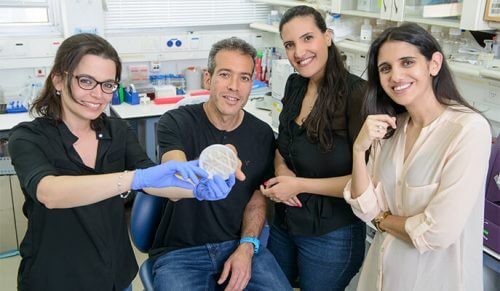The institute's scientists were able to identify several thousand "recruitment areas" on messenger RNA. These "recruitment areas" may constitute a kind of "target bank" for a variety of drugs for various diseases.

After deciphering the structure of the ribosome, the great challenges ahead of us are to understand how the ribosome is mobilized for the work of translating the genetic code for the purpose of building proteins; how it distinguishes between different genes; And how viruses that attack the cell "enslave" the cellular ribosome to create new viruses. in research recently published in the scientific journal Science, Weizmann Institute of Science scientists offer new insights in these fields.
Prof. Eran Segal and research student Shira Weingarten-Gabai, from the Department of Computer Science and Applied Mathematics, examined one of the most important steps in the process of producing proteins in the cell: the binding of the ribosome to the messenger RNA molecule. After this step, the ribosome reads the genetic information of the messenger RNA, and accordingly produces a protein. At the beginning of the messenger RNA molecule, and at the end, there are sequences that do not encode information needed to build a protein, but are used to control the protein creation process and the stability of the messenger RNA. Prof. Segal and the members of his group asked how the ribosome is "recruited" for the job, to which sequences it is attracted, and where these sequences are located on the messenger RNA molecule.
To test the "recruitment" of the ribosome, the scientists developed a technique of genetic engineering, which allowed them to build and test a library of approximately 55,000 genetic sequences, the exact composition of which the researchers determined. In this way, a variety of genetic variants was created, which made it possible to precisely examine the sequence (on the messenger RNA chain) to which the ribosome is "recruited". Some of these genetic sequences were exact copies of genes from the human genome, some were copies of the genetic cargo of viruses, and some were artificial sequences.
Until now, several dozen "recruitment regions" were known on the molecular chains of messenger RNA, which were located, quite predictably, at the beginning of the sequence that encodes information for building a protein. However, by examining the 55,000 sequences, the institute's scientists were able to identify several thousand "recruitment areas", surprisingly, a large part of which is located near the end of the coded sequence. This surprising finding changes the way we perceive the translation process of a messenger RNA molecule into a protein. It is now known that the molecular sequence of the messenger RNA is circular, forming a kind of loop. The findings of the institute's scientists imply that in some cases the ribosome can start the translation process from the end - instead of from the beginning - and move on top of the loop that is formed in a circular path.
The scientists say that the extent of a gene's ability (in the messenger RNA phase) to "recruit" a ribosome and create a protein is an important basic question, which also has significance in the field of medical applications. When viruses attack cells in our body, they use "recruitment sequences" on their messenger RNA to "hijack" the ribosome and build proteins that are used to produce new viruses, at the expense of the cell's proteins. It is possible to stop this process using a molecule of a medicinal substance, which will stick to the "recruitment area" in the genetic material of the virus, and prevent the ribosome from connecting to it. If a connection is not made, that is, if the ribosome is not "recruited", the proteins that build the virus will not be formed, and the disease it causes will not develop. The thousands of "recruitment areas" discovered in this study, in hundreds of different viruses, may therefore constitute a bank of targets for a variety of drugs for various diseases.
How exactly is the ribosome "recruited" for the job of assembling the protein, and what attracts it to a certain part on the messenger RNA chain? These questions still remain a mystery.
Participated in the study: research student Shani Elias-Kirma, Dr. Ronit Nir and Dr. Adina Weinberger from Prof. Eran Segal's laboratory; Dr. Noam Stern-Ginosar from the Department of Molecular Genetics; research student Alexey Gritchenko of Delft University in the Netherlands; and Dr. Zohar Yachini from the Technion and "Agilent" laboratories.

One response
Iran Segal with a huge laboratory that includes about 19 doctors, doctoral students and master's students and support engineers.
It is a factory for the production of articles and software.
Professor of Applied Mathematics. Booker PhD Stanford and Research Fellow at Rockefeller.
I saw that he was involved in determining different diets for people according to genome, and different treatments according to genome.
Developed quite a few dedicated software for mapping biological traits according to genome.